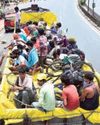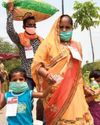
THE RELEASE OF THE COMPREHENSIVE National Nutrition Survey (CNNS 2016-2018) has renewed interest in tackling malnutrition in India. The conceptual framework for child undernutrition, developed by UNICEF, recognizes breastfeeding, good complementary feeding, caring and health care to minimize disease burden as immediate underlying factors that determine malnutrition in all its forms.
According to the CNNS, 35 per cent of the children under five were stunted (HAZ <-2 SD), 17 per cent were wasted (WHZ <-2 SD), and 33 per cent were underweight (WAZ <-2 SD). India has set ambitious targets to annually reduce stunting to 25 per cent by 2022. In the past decade, the focus of dealing with malnutrition has been tilting in favor of treating severe malnutrition with ready-to-use therapeutic foods (RUTF), projected as a magic solution for saving babies. However, a recent study from eastern India concluded: “Given that the risk of mortality is lower than expected among children older than 6 months and that many deaths occur because of prematurity or low birth weight during the neonatal period, outpatient treatment for SAM [severe acute malnutrition] using RUTF for children over 6 months may be too late to avert a substantial number of deaths from undernutrition in Indian children. This further strengthens the case for prioritizing prevention through known health, nutrition, and multisectoral interventions in the first 1,000 days of life.”
Nutrition action in India needs a rethink and reassessment. Some fundamental corrections are needed to change the focus from treatment to prevention.
Esta historia es de la edición November 8, 2019 de FRONTLINE.
Comience su prueba gratuita de Magzter GOLD de 7 días para acceder a miles de historias premium seleccionadas y a más de 9,000 revistas y periódicos.
Ya eres suscriptor ? Conectar
Esta historia es de la edición November 8, 2019 de FRONTLINE.
Comience su prueba gratuita de Magzter GOLD de 7 días para acceder a miles de historias premium seleccionadas y a más de 9,000 revistas y periódicos.
Ya eres suscriptor? Conectar

How Not To Handle An Epidemic
The lockdowns were meant to buy time to put in place appropriate health measures and contain the coronavirus’ spread, but they have failed to achieve the objective and heaped immense misery on the marginalised sections of society. India is still in the exponential phase of the COVID-19 infection and community transmission is a reality that the government refuses to accept.

Tragedy on foot
As the COVID-19-induced lockdown cuts the ground beneath their feet in Tamil Nadu, thousands of migrant workers are trudging along the highway to the relative safety of their upcountry homes.

Sarpanchs as game changers
Odisha manages to keep COVID-19 well under control because of the strong participation of panchayati raj institutions and the community at the grass-roots level under the leadership of Chief Minister Naveen Patnaik.

Scapegoating China
As the COVID-19 death rate spikes and the economy tanks in the United States, Donald Trump and his advisers target China and the World Health Organisation with an eye to winning the forthcoming presidential election.

New worries
Kerala’s measured approach to the pandemic and lockdown has yielded results. But it still has to grapple with their huge economic impact on its economy, which it feels the Centre’s special financial relief package does little to alleviate.
No love lost for labour
Taking advantage of the lockdown and the inability of workers to organise protests, many State governments introduce sweeping changes to labour laws to the detriment of workers on the pretext of reviving production and boosting the economy.

Capital's Malthusian moment
In a world that needs substantial reorienting of production and distribution, Indian capital is resorting to a militant form of moribund neoliberalism to overcome its current crisis. In this pursuit of profit, it is ready and willing to throw into mortal peril millions whom it adjudicates as not worth their means—an admixture of social Darwinism born of capital’s avarice and brutalism spawned by Hindutva. .

Understanding migration
When governments and their plans are found to be blatantly wanting in addressing reverse migration, exercises such as the Ekta Parishad’s survey of migrant workers throughout India can be useful to work out creative long-lasting solutions.

Waiting for Jabalpur moment
The Supreme Court’s role in ensuring executive accountability during the ongoing lockdown leaves much to be desired. Standing in shining contrast is the record of some High Courts.

An empty package
The Modi regime, which has been unable to control the COVID-19 infection, restore economic activity and provide relief to millions exposed to starvation, trains its sights on Indian democracy, making use of the panic generated by fear and a lockdown that forecloses paths of resistance.